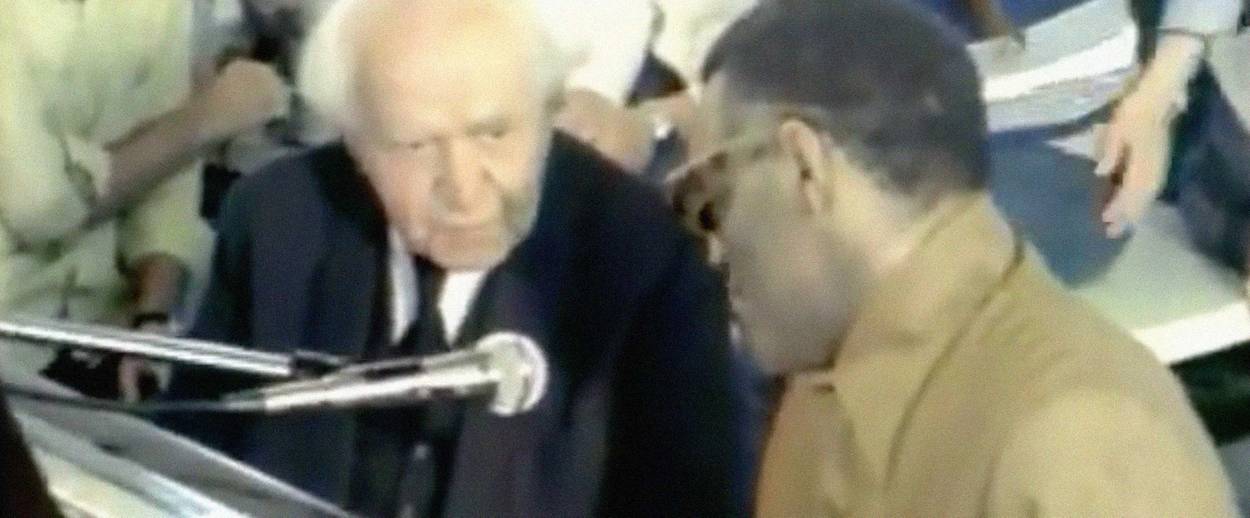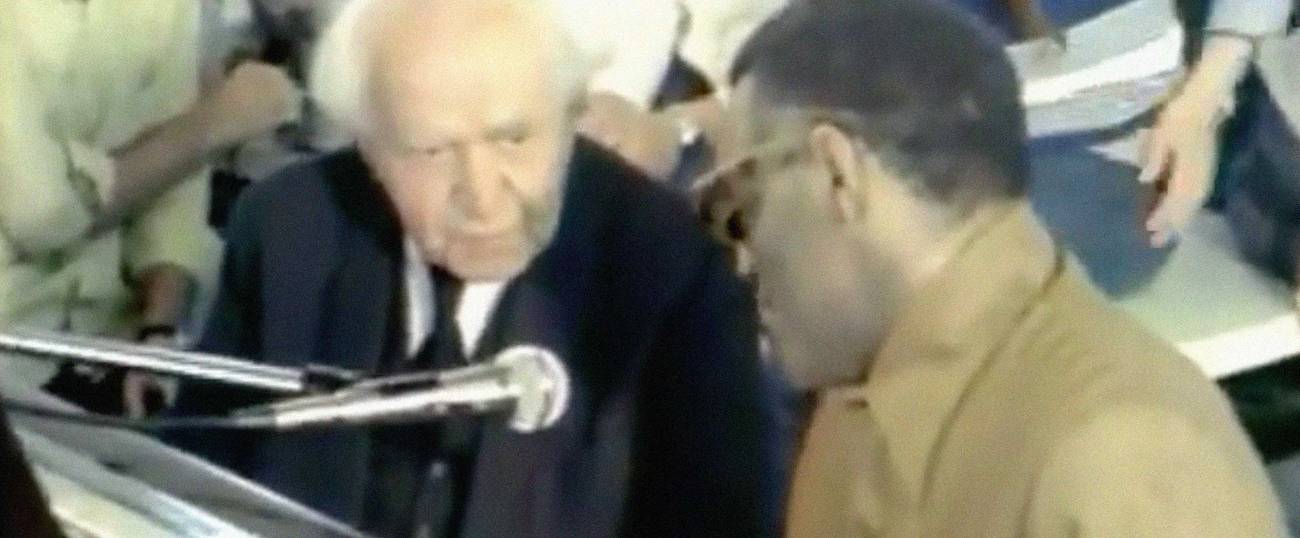Ray Charles in Israel
When the ‘Genius of Soul’ sang ‘Hava Nagila’ with David Ben-Gurion




“I had always heard that I was popular in Israel, but I didn’t get over there until the early seventies,” the soul genius Ray Charles recalled. “Some people asked me to do a documentary. I liked the idea. I’d never done anything like that before. The film people knew I wasn’t a scholar or a theologian, but they had heard that I had a decent working knowledge of the Bible. They had also heard that the Israelis liked me, and they hoped the two things would blend.”
Ray Charles, accompanied by his five backup singers, the Raelettes, arrived in Israel in early December 1972. In the first two weeks of that month they performed at five wildly successful concerts. Israeli fans of the “Genius of Soul” thronged the concert halls of Jerusalem, Tel Aviv, and Haifa. Fans cheered the musicians in the streets and the press gave their concert tour wide coverage.
The musicians spent two weeks performing and touring in the country. It was, Charles remembered, an opportunity to “look around and learn. … It was all so old, so incredibly old, that I couldn’t help but shake my head in wonder. I could smell history in the streets.”
By the early 1970s, Ray Charles and the Raelettes had given concerts all over the world. In Japan, they had encountered particularly enthusiastic audiences. But in terms of enthusiasm none of these concerts prepared Charles and his ensemble for the reception they received in Israel.
That many Israelis liked Ray Charles and his music was an understatement. I was living in Jerusalem at the time and I remember vividly the excitement that his visit generated. I also remember that by the time I made it to the concert hall box office the two Jerusalem shows were completely sold out. I never got to hear him on that tour, but news of it was in all of the Israel newspapers. It seemed that by missing that concert I had missed more than the music.
The riveting story of the Jerusalem concert is best told by the genius himself: In his autobiography, Brother Ray, (co-written with David Ritz) Charles wrote that, “In thirty years on the road, I had never experienced anything like this. We were supposed to do two shows, but the first one had the crowd so crazy and happy that they wouldn’t leave. The second crowd was due any minute, but the first crowd wasn’t about to move.”
The concert promoters were rattled by the raucous audience and wanted to clear the hall by force. But Charles suggested that they announce that ticket holders to the first show will be allowed to stay in the hall, as long as they gave up their seats. As Charles remembered, “He made the announcement and everyone cheered. So for the second show there were Israelis everywhere. … I was sure glad the place didn’t catch fire, because we all would have burned up together. But fortunately the only fire was the one in them and in me. I can’t remember ever feeling more loved.”
Three decades later, Mable John, lead singer of the five-member Raelettes, recalled her own vivid memories of the reception the musicians got in Israel:
In a 2004 interview she said:
It wasn’t just the show but how they treated us—and that gave me such a love for Israel. Our flight going into Tel Aviv was five hours late so it looked like we would have to perform in the same clothes we wore on the plane. There were people all around the building and we were supposed to do two shows. We went into a dressing room to freshen up and there were all these people on their knees outside the windows looking at us! Now it wasn’t that they were trying to spy or see us without our clothes on—it was adoration!
We finally got on the stage so late that we didn’t do our usual part of the show and we were supposed to do a second show but the people from the first one wouldn’t leave. We thought there was going to be a riot! Well, they let the people from outside in and they sat on and all around the stage—we did one show for two shows’ worth of people in that room!”
Ray Charles was in his early 40s when he visited Israel. Born in 1930 in rural Georgia, he emphasized to friends and fans that deep down he was “a country boy … and, man, I mean the real backwoods. … All I ever saw—and I’m talking literally—was the country. I didn’t lose my sight till I was 7. It happened gradually. So I have years of pictures of country places, country people, country animals in my mind.”
Blinded by a juvenile glaucoma, a hereditary disease, Ray was sent to the “colored department” of the Florida State School for Deaf and Blind. It was in his second year at the school learning to play music and taking instruction in how to do musical notation in Braille that he declared his ambition to be “ a great musician.” Through hard work he achieved that ambition by the time he was in his mid-20s.
During his two-week tour, Charles also visited former Israeli Prime Minister David Ben-Gurion at Kibbutz Sde Boker in the Negev, as I recount in Starstruck in the Promised Land. Israel’s founding father was then 87 years old. The meeting between the King of Soul and Ha-Zaken, “the Old Man” as he was known affectionately by Israelis, has been preserved on film. In the documentary Soul of the Holy Land, released after Charles’ death in 2004, we can hear the children of Sde Boker join Ray and Ben-Gurion singing “Hava Nagilah.” Ray then sang Stevie Wonder’s song “Heaven Help Us All” for Ben-Gurion and the kibbutzniks.
In 1976, four years after he had visited Israel, B’nai B’rith honored Ray Charles as its Man of the Year. Accepting the award at a dinner in Beverly Hills, Charles said, “Even though I’m not Jewish … Israel is one of the few causes I feel good about supporting. Blacks and Jews are hooked up and bound together by a common history of persecution. If someone besides a black ever sings the real gut-bucket blues, it’ll be a Jew. We both know what it’s like to be someone else’s footstool.”
Responding to reports of anti-Jewish feeling expressed by some African Americans, Charles said, “I’ve heard about anti-Semitism among blacks in America, but I never paid that much mind. … But that prejudice is narrow and stupid, and fortunately short-lived. For the most part we’re two peoples who work well together. And in many instances, there is real love between us.”
By the late 1970s, though, many people on the left—including activists in African American communities—would begin to challenge the assertion that the two liberation movements of historically oppressed, despised, and ghettoized people should continue working together, or see their collective struggles as in any way equivalent.
Ray Charles never bought it. In 1982, a decade after his first visit, he returned to give a series of sold-out performances. And in 1987, on his last visit, he performed in the former Roman amphitheater at Caesarea. The Israeli jazz saxophonist Nadav Haber was at that performance. He told a Haaretz reporter that even in that large performance space, Charles managed to create a feeling of intimacy. “Ray,” Haber said, “is the kind of artist who takes you in a kind of trance; you leave altered. Many people in the amphitheater came to relax and enjoy themselves. I came to be with Ray, and that is what actually happened.”
Shalom Goldman is Professor of Religion at Middlebury College. His most recent book is Starstruck in the Promised Land: How the Arts Shaped American Passions about Israel.